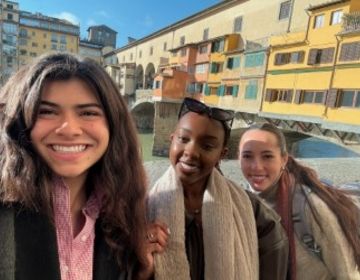The Ultimate Guide to Studying Abroad in Florence
Fresh-cooked al dente pasta, Michelangelo, medium-bodied Chianti wine, the Roman Empire – what doesn’t come to mind when you think of Italy?
Italy’s rich history, near-perfect climate, and renowned beauty make it one of the world’s most famous and influential countries. In fact, Italy’s boot-shaped borders welcome millions of visitors each year, making the country a top-ranked tourism destination.
Tourists and international students alike can agree that if you choose to visit Italy, you can be certain you’re choosing a country that has it all: 2,500 years of rich history in dynamic Rome, artistic tradition in scenic Florence, and fashion-forward style in urban Milan. No matter which Italian gem you choose, you're sure to have the study abroad experience of a lifetime in Italy!

Read More: Top 3 Best Places to Study Abroad in Italy
Florence vs. Milan vs. Rome
Italy’s many inspiring cities have uniquely contributed to the country’s history and intrinsic personality and are key places to visit when traveling around or studying abroad in the country.
Visiting Florence
Located in central Italy, Florence is known as the capital of Italy’s Tuscany region, surrounded by rolling hills and villas. Famous for its Renaissance art, architecture, and astonishing monuments, Florence is also home to quintessential Italian farms and vineyards. Think rom-coms like Letters to Juliet or the classic A Room with a View. In love with the idea of studying abroad in Florence, yet? Us, too!

Visiting Milan
Also known for its architecture, Milan is Italy’s second-largest city, situated in northern Italy, where it boasts a fabulous scene for fashion, cuisine, and history. Milan features the Duomo de Milan, the third-largest Catholic church in all of Europe, as well as the Milan Cathedral, an impressive structure that took more than 500 years to build.

Visiting Rome
As the capital of Italy and the largest city in the country, Rome is recognized for its historic sites and amazing culture. It’s a must-see destination for any student studying abroad in Italy. Fun facts we bet you don’t know: More than €1 million is tossed into Rome’s Trevi Fountain each year, and this historic city even includes a museum entirely dedicated to pasta – deliziosa!

While each of these incredible Italian cities has something to offer, let’s unpack why Florence is considered one of the best places to study abroad in Italy.
Why Study Abroad in Florence
Home to a treasure trove of Renaissance jewels and a rich cultural heritage, Florence is considered the birthplace of the Renaissance and is rooted in artistic tradition. This beloved city offers endless opportunities to immerse yourself in Italian culture and authentically explore the country.
Here are five top reasons why you should study in Florence:
Reason #1: Explore timeless art.
You’ll have an opportunity to discover the many museums in Florence that house some of the most famous pieces of art in the world. In the Uffizi Gallery, you’ll feast your eyes on artwork created in the 15th and 16th centuries, stare in awe at the original sculpture of the David by Michelangelo at the Accademia Gallery, and visit the Palazzo del Bargello, Italy’s first national museum that opened in 1865.
You won’t want to miss the Palazzo Vecchio, which boasts an entire room adorned with works by Michelangelo and Leonardo DaVinci. And the Museo Salvatore Ferragamo is not to be missed either, as it showcases the legendary shoemaker’s influence on shoe design and features some of his finest work from his partnerships with famous American and Italian productions and actors, including Charlie Chaplin.
In short, you can spend an entire semester just exploring Florence’s museums.
Reason #2: Become a sommelier.
Florence is the undeniable capital of Tuscany, a region world-famous for its 100 vineyards and wineries that all experiment with different local and international grape varieties. Chianti, one of the most well-loved wines, comes from this region.
You’ll get to dive deep into the history of winemaking and its impact on Italy, so it’s even a fun opportunity for those who aren’t interested in drinking it. History flows freely here! With CIEE, you’ll visit some of the oldest wineries in Tuscany, like Castello di Camigliano.
Reason #3: Gain global perspectives.
There’s no denying Italy’s global impact on the arts, cuisine, fashion, and then some. Florence is home to iconic Italian sites that are rich in history, including Siena – one of the most important cities of the European Middle Ages.
The Historic center of Siena is a well-preserved UNESCO-listing, meaning its cultural significance is considered to be of “Outstanding Universal Value.” How’s that for an accolade?
In addition to learning more about Italy’s deep-rooted history, by studying abroad, you’ll broaden your understanding of the world outside U.S. borders and yourself. Traveling to understand (not just to eat!), making lifelong connections, acquiring essential skills, and ultimately becoming your best self are just some of the many ways an experience like a study abroad program will enhance your life.

Reason #4: Indulge in some of the finest cuisines.
Italy is the birthplace of some of the most globally famous foods and drinks, including pizza, risotto, pasta, gelato, coffee, and espresso, and much more. If you think you’ve tasted these foods before, think again.
Florence features endless restaurants and bakeries where you can experience authentic Italian food – trust us when we say you’ll be thinking about Florence cuisine for years after visiting.
Reason #5: Travel most of Florence on foot.
Florence is considered one of the most tourist- and student-friendly cities in the world due in part to its walkability. You can explore the city almost entirely on foot, making it a fun and affordable study abroad option!
For travel outside the city, Florence has many transportation options including buses, trams, and taxis.
How to Study Abroad in Florence
After discussing the opportunity with your family and academic advisors, keep in mind the following steps before beginning your journey to study abroad in Florence.
Step #1: Determine your timeframe.
CIEE offers a variety of ways to study abroad in Florence, including semester-long sessions, summer study abroad, and J-term, with program lengths ranging from four weeks to 18 weeks. With flexible options, it’s important to select a timeframe that makes sense with your personal and academic schedule.
Step #2: Choose a program you’re passionate about.
After determining your timeframe, find a program that meets your academic and career goals. Choosing a program you’re passionate about will help you make the most of your Florence study abroad experience.
It’s a good idea to connect with your academic and study abroad advisors before settling on any one program. And we’re always here to help, too.
Step #3: Verify your eligibility.
Make sure you’re eligible to participate in CIEE’s Florence study abroad offerings. Every program has its own requirements, but typically include a minimum GPA and often other course and credit requirements, too. It’s important to review these items before applying to your chosen program.
Step #4: Create a budget.
While studying abroad in Florence is considered an affordable study abroad option, it’s always a smart idea to budget for other expenses, like incurred travel expenses, gifts, and food.
CIEE also offers millions in study abroad scholarships and grants each year based on several factors including financial need, academic merit, and other considerations, to allow you to make a study abroad dream a reality.

Step #5: Apply!
The easiest step is applying! After determining your ideal program and reviewing and applying to scholarship and grant opportunities, you’re ready to apply to your Florence study abroad program! We’re available for any application questions you may have.
Florence Study Abroad Packing Tips
There are several items you’ll want to make sure you have before embarking on your study abroad trip to Florence.
Keep in mind that the weather in Florence is usually warm and temperate, with humid summers averaging around 75 degrees Fahrenheit and cold, rainy winters ranging from 40 to 50 degrees Fahrenheit.
Here’s a brief list of essential items to pack, including important travel documents:
- Passport
- Student visa
- A second form of valid ID
- Plane tickets
- Proof of health insurance
- Proof of CIEE enrollment
- Financial information
- Comfortable walking shoes
- Prescription medications
- Power adapters and converters
- Currency
- A few neat outfits
Read More: What to Pack When Studying Abroad in Europe
Study Abroad Florence Tips
Each country has its own customs and norms – be mindful of these things when you’re studying abroad in Florence.
Basic etiquette
It’s a sign of respect to dress neatly when visiting Italy’s museums and holy sites. When inside a holy building, make sure your shoulders, knees, and midriff are covered.
Avoid public conversations that may be considered controversial, including statements about the Catholic Church, the Pope, possible stereotypes, and other controversial topics about Italy’s past.
Italy is known for its many traditions, including the country’s emphasis on respect. Make sure to cover your mouth when yawning or sneezing, open doors for the elderly, remove your hat when indoors, and stand and shake hands when greeting others.
Eating
Sharing meals is an important activity in Italy. There are a few basic things to remember when dining, including:
- If dining with Italian hosts, don’t begin eating your meal until a host or head of the table signifies you can begin
- It is considered improper to place your hands on the dining table
- It is generally impolite to eat while talking or walking

Communication
Italy’s official language is Italian, although many locals speak English, as well as other languages. There are several popular phrases to consider using when traipsing throughout Florence, like:
- “Buongiorno,” meaning good morning
- “Ciao,” meaning hello any time of day
- “Grazie,” meaning thank you
- “Per favore,” meaning please
- “Buona sera,” meaning good evening
- “Buona notte,” meaning good night
- “Salve,” meaning hello in a formal setting
- “Arrivederci,” meaning goodbye
Safety
As is necessary when traveling anywhere, make sure to be aware of your surroundings and keep personal and important items on your person. Florence is considered one of the safest places to visit and study abroad in Italy but remember to take normal precautions when visiting.
And remember, CIEE is available for safety support 24/7, so if you ever have any questions or concerns, we've got you covered.
Florence is Calling
Studying abroad in Florence is a once-in-a-lifetime opportunity – you’ll immerse yourself in the local culture, visit famous sites, and make new friends.
Don’t wait any longer – start planning your Italian journey today!
Related Posts
Finding Home in Rome
By: Lisa Msuya When deciding what study abroad program I would pursue, as soon as I saw Rome, Italy, I knew immediately that it would be the place for me... keep reading
Life-Changing Semester in Rome
By: Haley Carlson Studying abroad in Rome with CIEE is more than just an adventure—it’s a transformative experience that pushes you to grow in ways you never imagined. From the... keep reading
Top 5 Italian Holidays and Traditions
Ever wondered what it's like to celebrate like an Italian? Spoiler alert: It's not just about pizza and pasta. When you mix ancient traditions, mouth-watering food, and a dash of... keep reading




